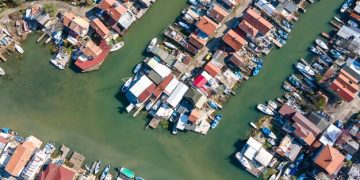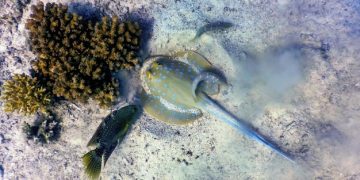Climate Change’s Impact on US Fish Migration Patterns
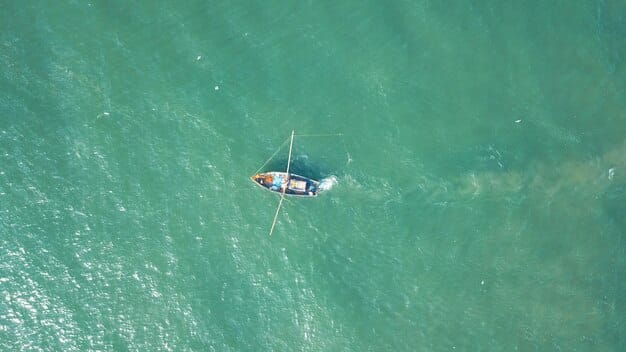
Climate change significantly alters the migration patterns of key fish species in US waters by disrupting habitats, food sources, and thermal ranges, leading to shifts in distribution and abundance with profound ecological and economic consequences.
The intricate dance of marine life beneath the waves is largely unseen, yet profoundly affected by shifts in our planet’s climate. One of the most compelling and concerning manifestations of this global phenomenon is how climate change is affecting the migration patterns of key fish species in US waters. As ocean temperatures rise and marine ecosystems evolve, fish populations are forced to adapt or face decline, impacting everything from commercial fisheries to the delicate balance of oceanic biodiversity.
understanding marine migration and its drivers
Marine fish migration is a complex biological phenomenon driven by a multitude of environmental cues. These movements are essential for species survival, facilitating reproduction, foraging, and predator avoidance. Understanding these drivers is crucial to appreciating the profound effects of climate change.
Historically, fish have followed predictable routes and timings, refined over millennia. These patterns are often determined by the interplay of temperature, food availability, and the presence of suitable spawning or nursery grounds. Disruptions to any of these factors can have cascading effects on marine ecosystems.
key environmental triggers for migration
Fish rely on a sophisticated array of environmental signals to navigate their migratory journeys. These triggers are typically stable and predictable across seasons and years, allowing species to optimize their life cycles.
- Temperature: Many species have narrow thermal preferences, dictating when and where they can feed or reproduce.
- Salinity: Changes in freshwater runoff can alter localized salinity, influencing estuarine and coastal migrations.
- Currents and Ocean Gyres: Major ocean currents often act as highways for migrating fish, transporting them efficiently.
- Photoperiod: The length of daylight hours can signal seasonal changes, prompting migratory behavior.
The sensitivity of fish to these cues means that even subtle shifts in ocean conditions can trigger significant changes in their behavior. The precise timing and routes of migration are critical for the successful maturation of offspring and the ability to find sufficient food resources.
These natural drivers form the baseline against which the impacts of climate change must be evaluated. When these environmental cues become unreliable or shift unexpectedly, the migratory strategies that have sustained fish populations for generations can become maladaptive, posing significant threats to species viability.
the undeniable warming of US waters
The most direct and pervasive impact of climate change on marine environments is the rise in ocean temperatures. US waters, from the Gulf of Maine to the Pacific Northwest and the Gulf of Mexico, are experiencing unprecedented warming rates, far exceeding historical averages.
This warming is not uniform; some regions are heating up faster than others, creating complex thermal gradients that challenge fish species accustomed to specific thermal envelopes. This rapid change outpaces the evolutionary capacity of many species to adapt in place.
regional hotspots of ocean warming
Certain regions along the US coastline are experiencing particularly dramatic temperature increases, leading to noticeable shifts in marine species distribution.
- Gulf of Maine: One of the fastest-warming bodies of water globally, experiencing significant shifts in cod and lobster populations.
- Alaska Waters: The Bering Sea and Gulf of Alaska are seeing reduced sea ice and warmer temperatures, affecting species like pollock and salmon.
- Southeast US Coast: Warmer waters contribute to more frequent and intense marine heatwaves, pushing tropical species northward.
These regional hotspots exemplify how localized thermal changes can accelerate migratory shifts, forcing fish to seek cooler waters or face physiological stress. The consequences extend beyond individual species, impacting the entire food web and the ecosystems they inhabit.
The continuous monitoring of sea surface temperatures and deeper ocean layers is essential for understanding the scale and speed of these changes. Data from NOAA and other scientific bodies consistently show an upward trend, corroborating the direct link between global climate change and localized marine warming.
shifting distributions: new homes for fish species
As US waters warm, many fish species are responding by shifting their geographic distributions, often moving poleward into cooler, previously less hospitable waters, or into deeper, colder offshore areas. This phenomenon, often referred to as “ocean reddening” (analogous to terrestrial plant shifts), represents a fundamental reorganization of marine communities.
These shifts are not merely incremental; they can involve hundreds of kilometers over a few decades, fundamentally altering the species composition of regional fisheries and ecosystems. The implications for fishing communities, conservation efforts, and ecosystem stability are profound.
case studies of northward and deeper movements
Numerous scientific studies and anecdotal observations from fishermen confirm these widespread migrations across various species important to US fisheries.
- Atlantic Cod: Historically abundant in the Gulf of Maine, cod populations are moving further north into Canadian waters as their preferred cold-water habitats shrink.
- Black Sea Bass: Once primarily found in mid-Atlantic waters, black sea bass are now common in the Gulf of Maine, posing new management challenges as they expand their range.
- Lobster: Maine’s iconic lobster industry is benefiting from warmer waters initially, but sustained warming could push lobsters further north, out of traditional fishing grounds.
- Summer Flounder (Fluke): This valuable recreational and commercial species is extending its range northward along the US East Coast.
These range expansions often bring new species into competition with existing ones, potentially disrupting established predator-prey relationships and leading to unforeseen ecological consequences. For example, the arrival of new predators can decimate local prey populations that have not evolved defenses against them.
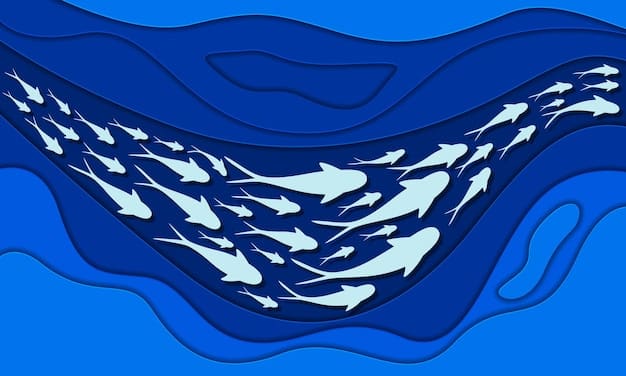
The speed of these shifts also outpaces the pace of traditional fisheries management, which tends to be based on static, historical distributions. This creates a disconnect between where fish are found and where they are legally allowed to be caught, leading to management dilemmas and potential overfishing of localized “new” populations.
The displacement of species can also leave behind ecological “vacuums” in their historical habitats, potentially leading to a decrease in biodiversity or an increase in invasive species that can tolerate warmer conditions. This complex interplay of movement and void creates a dynamic, uncertain future for marine life in US waters.
disruptions to marine food webs and ecosystems
Fish migration is not an isolated event; it is interwoven with the broader dynamics of marine food webs. Changes in migratory patterns often create ripple effects throughout the ecosystem, impacting prey availability, predator success, and the overall health of marine habitats.
When fish move, their predators must follow, adapt to new food sources, or face starvation. Similarly, prey species may find themselves in new environments without their traditional predators, leading to population explosions or, conversely, a lack of essential ecological services like nutrient cycling.
cascading effects through trophic levels
The interconnectedness of marine life means that a change in one species’ migration pattern can affect many others.
- Predator-Prey Mismatches: If a predator species migrates at a different rate or to a different location than its primary prey, both populations can suffer. For instance, seabirds that rely on specific fish for nesting may find their food sources have disappeared.
- Altered Foraging Grounds: Fish may arrive at traditional feeding grounds only to find that the plankton blooms they rely on have shifted in time or space due to warming waters.
- Increased Competition: New arrivals in a region can increase competition for resources with resident species, potentially leading to declines in native populations.
These disruptions extend beyond fish. Benthic organisms, like corals and shellfish, are often stationary and cannot follow shifting temperature zones. Their reliance on specific temperature ranges and ocean chemistry (e.g., pH for shell formation) means they are particularly vulnerable to warming and acidification, further impacting the base of the food web.
The ecological services provided by various fish species, such as nutrient cycling, habitat modification, and seed dispersal, can also be compromised when their migratory patterns are altered. This contributes to a general decline in the resilience and productivity of marine ecosystems.
Understanding these cascading effects requires a holistic approach to marine research and management, recognizing that the ocean is a dynamic, interconnected system where change in one part inevitably affects the whole.
impacts on US fisheries and coastal communities
The shifts in fish migration patterns have direct and often severe economic consequences for US fisheries and the coastal communities that depend on them. These communities, many of which have decades or centuries of fishing heritage, are grappling with unpredictability and the need to adapt rapidly.
Traditional fishing grounds may become unproductive, forcing fishermen to travel further, chase different species, or endure reduced catches. This impacts incomes, employment, and the very social fabric of these coastal towns.
economic and social ramifications
The economic ramifications of altered fish migrations are far-reaching, affecting various sectors of the marine economy.
- Reduced Catches and Quotas: As fish stocks move, traditional fishing fleets may find their quotas unfulfilled or face lower catch rates in their historical areas. This directly impacts their profitability.
- Increased Fuel and Operational Costs: Chasing shifting fish populations means longer trips, more fuel consumption, and higher operational expenses for fishing vessels.
- Conflict and Management Challenges: Fish moving into new management zones can create conflicts between states or countries over shared resources, complicating quota allocations and regulatory enforcement.
- Infrastructure Mismatch: Port infrastructure, processing plants, and markets are often built around specific fish species from particular regions. Shifts in fish distribution can render this infrastructure obsolete or underutilized.
Beyond the economic, there are significant social impacts. Generational fishing families face uncertainty, and the cultural identity tied to fishing can erode. The stress on these communities highlights the human dimension of climate change impacts on marine ecosystems.
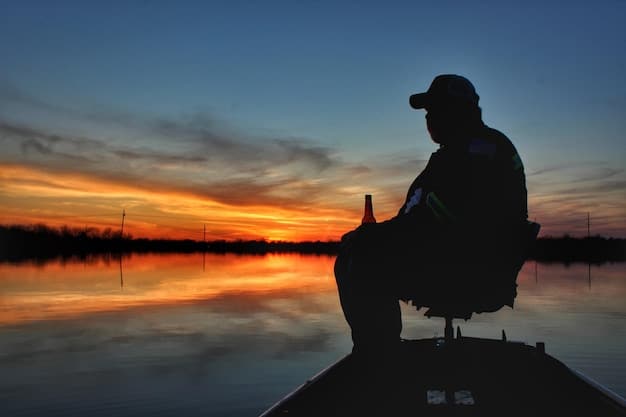
While some regions may temporarily benefit from the influx of new species, this often comes with its own set of challenges, including a lack of familiarity with new fishing techniques, market changes, and potential conflict with existing fisheries. Ultimately, the overall trend points towards increased instability and uncertainty for the US fishing industry.
The need for adaptive fisheries management and economic diversification in coastal communities becomes increasingly urgent as these changes accelerate. This includes investment in new technologies, retraining programs, and support for sustainable aquaculture and other marine-based industries.
adaptive strategies and future outlook
Addressing the complex challenge of altered fish migration patterns due to climate change requires a multi-faceted approach involving scientific research, adaptive management, and international cooperation. It is a challenge that demands innovation and flexibility from scientists, policymakers, and fishing communities alike.
While the scale of climate change can seem overwhelming, proactive measures can help mitigate its impacts and foster resilience in marine ecosystems and human societies.
innovations in fisheries management and conservation
New strategies are emerging to cope with the dynamic nature of marine resources in a warming world.
- Dynamic Ocean Management: Moving away from static management zones to more flexible systems that adapt to real-time changes in ocean conditions and fish distribution. This includes dynamic closures and adaptive quotas.
- Enhanced Data Collection and Modeling: Investing in robust ocean observing systems and predictive models to forecast species movements and identify potential ‘climate refugia’ – areas where conditions may remain stable longer.
- Ecosystem-Based Management: Managing entire ecosystems rather than individual species, recognizing the interconnectedness of marine life and the food web. This includes protecting critical habitats.
- Transboundary Cooperation: Facilitating greater collaboration between states and nations as fish stocks move across traditional borders, ensuring shared responsibility and sustainable management.
Furthermore, supporting diverse fishing practices and fostering community resilience through economic diversification are critical. This means empowering coastal communities to adapt to changing conditions rather than being solely dependent on traditional fishing practices that may no longer be viable.
The future outlook for key fish species in US waters is largely dependent on the speed and efficacy of global climate action. While localized adaptation strategies are vital, the underlying driver of altered migration patterns is global warming. Reducing greenhouse gas emissions remains the most fundamental long-term solution.
Continued investment in scientific research will be paramount to understanding the ongoing changes and developing effective solutions. By combining rigorous science with flexible management and strong community engagement, it may be possible to navigate these turbulent waters and secure a more sustainable future for marine life and the fisheries that rely upon it.
| Key Aspect | Brief Description |
|---|---|
| 🌡️ Ocean Warming | Rising sea temperatures force fish to seek cooler habitats, altering historical ranges. |
| ⬆️ Poleward Shifts | Many species are moving towards the poles or into deeper waters to escape warming. |
| 🔗 Food Web Disruption | Changes in migration can mismatch predators and prey, impacting entire ecosystems. |
| 🎣 Fishery Impacts | Coastal economies face challenges due to unstable catches and shifting fishing grounds. |
frequently asked questions about fish migration and climate change
▼
The primary driver is rising ocean temperatures due to climate change. Fish species are highly sensitive to specific thermal ranges, and as waters warm, they migrate to cooler areas to find suitable conditions for survival, feeding, and reproduction. Other factors like ocean acidification and altered current patterns also play a role.
▼
Coastal waters across the US, including the Gulf of Maine, the Bering Sea, and the Southeast Atlantic, are experiencing significant warming. These regions are seeing species like Atlantic cod, black sea bass, and various groundfish shift their distributions poleward or into deeper waters to escape increasingly unfavorable conditions.
▼
Shifting migration patterns can cause trophic mismatches, where predators and their prey are no longer in sync in time or location. This disrupts food webs, leading to increased competition among species, potential declines in vulnerable populations, and altered ecosystem structure and function, impacting overall biodiversity.
▼
Fisheries face significant economic challenges, including reduced catches in traditional areas, increased operational costs due to longer trips, and conflicts over shifting fish stocks between management zones. Coastal communities dependent on fishing may experience economic instability, job losses, and threats to their cultural heritage.
▼
Strategies include dynamic ocean management, which adapts fishing regulations to real-time fish movements, and ecosystem-based management that considers the entire marine food web. Enhanced data collection, predictive modeling, and transboundary cooperation are also crucial for informing policies and fostering resilience in response to continuous changes.
conclusion
The reshaping of fish migration patterns in US waters is a compelling testament to the pervasive and profound impacts of climate change on our planet’s oceans. From the economic stability of coastal communities to the delicate ecological balance of marine food webs, these shifts present unprecedented challenges. While the scale of the issue demands global action on greenhouse gas emissions, continued investment in robust scientific research, adaptive fisheries management, and international collaboration will be critical to safeguarding marine biodiversity and ensuring the sustainability of vital ocean resources for future generations.



